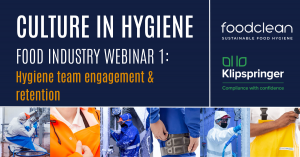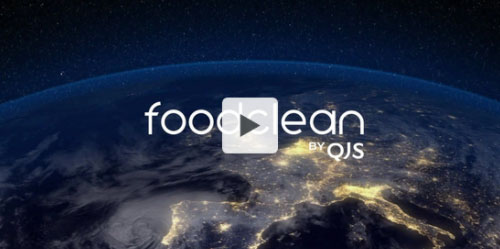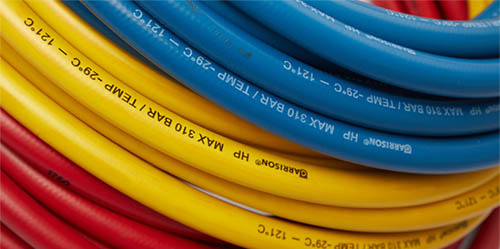Webinar 1 - Review
Hygiene Team Engagement & Retention
In the first of our Culture in Hygiene webinar series, FoodClean’s Lars Turner is joined by Alex Carlyon, Director at Klipspringer, and Phil May, Technical Support Manager for Greencore, shared their thoughts and ideas regarding hygiene team engagement and retention.
Hygiene teams are an immensely import cog in the factory machine and at the end of the day, if it’s not clean, a food manufacturing facility can’t produce. That’s why it’s so important to have an engaged hygiene workforce, as this will ensure that the job is done properly, plus employee retention is maximised in what can be a very challenging and volatile labour market.
What is culture?
Our specialists began by discussing how hygiene culture is a live organism. If you leave it, it will either die or go bad. However, when nurtured in the correct way, it will become self-sustaining and can be the secret to the success of your food manufacturing business. Like the bloodstream, culture affects every department of a company and impacts how each one performs. If the blood is bad, all of the organs will be contaminated. It starts at the top and it very quickly filters down.
Some key points covered here included:
- It doesn’t matter how big or small your organisation, or how big or small the team, culture does spread, for good or for bad.
- As leaders, team managers and supervisors, we are seen as an example by the rest of the team.
- Great culture equals great results. Good culture achieves team buy-in, passion, accountability, productivity and efficiency.
- Why does culture go bad? It can be due to neglect, a poor working environment, low engagement, lack of training, breakdown in trust, putting yourself ahead of the team, bad-fit recruits, and a combination of over-promising and under-delivering.
Phil May of Greencore touched on how it’s important for everyone to follow the same rules when on site, regardless of who they are and the reason they’re there. Whether it’s someone famous or a member of the team sweeping the floors, it doesn’t matter. The culture should be the same for everyone.
Choosing the right equipment for your teams
Lars Turner then went on to discuss how management teams can protect their hygiene operatives through the right kind of PPE and protective clothing. It’s crucial to remember that every member of staff requires the right workwear – it not only needs to be fit for purpose but also comfortable to wear.
“First impressions count,” stated Lars. “It’s the first thing the hygiene team will come into contact with. It’s essential to get it right. It’s good to have something that’s theirs, that they can be invested in and look after. They rely on having the gear that they trust.”
When buying PPE, you should always take an operator-first rather than a cost-first approach. This will ensure that comfort is key and saves your business time and money in the long run – if the gear is specifically chosen to fulfil the needs of your cleaning teams, they’re more likely to look after it.
Protecting against chemicals
A common misconception is that wetsuits are appropriate for the protection of hygiene staff. However, it’s essential to know the difference between wetsuits versus chemical suits to make sure the needs of your hygiene staff are met.
“A well-protected, looked after team is a happy, effective and loyal one. This helps with labour retention,” explained Lars. “Every site is under pressure to reduce its environmental impact. With costs on the rise, it’s more important than ever. Consider disposable versus re-usable suits. Re-usable suits save money and have a positive financial impact.”
It’s here that we loop back to how hygiene culture can be affected by key decisions, such as the equipment we choose for our cleaning teams. Again, an operator-first approach to the purchasing of equipment is crucial, as ‘operator-owned’ equipment increases its lifespan and leads to higher motivation. Rather than trying to find a one-size-fits-all solution, consider giving people their own toolbox that matches their needs. This philosophy leads to a sense of value and feeling valued, as well as higher comfort and a reduction in injury.
“Buying premium kit isn’t always about buying higher grade materials,” Lars clarified. “It’s about the features of that kit. Easier to pull triggers, for example, or higher flexibility in hoses can make shifts a better place to be. Constant feedback and communication with your hygiene teams will find those areas.”
In addition, everything you give your hygiene teams should be trackable and traceable, allow them to manage their equipment, ensure it’s not going missing, and that it’s not being appropriated by others.
“Having the right kit at the right place at the right time is key for productivity. It increases the effectiveness, and more importantly, the safety of the hygiene staff. There’ll also be a significant reduction in your hygiene window, meaning you’ll save money in the long run as your staff are able to work faster and more effectively.”
Sustaining food practice in induction and training
Alex Carlyon at Klipspringer then shared some fantastic insight into the importance of remembering that for some staff, this will be their first time stepping into a food manufacturing setting, so it will be entirely new territory for them. That’s why it’s crucial that you start with the basics and invest in the induction and training process.
“Thorough induction and training shouldn’t just be for contracted staff, but agency staff too. Treat them the same,” explains Alex. “Look at the complete training process and engage with recruitment agencies as a resource where required. Have a detailed training plan with timelines and incorporate hands-on training as well as the theory. Be mindful of language barriers. Remember that training is never a finished article.”
These are all excellent points, as making induction and training a visual process is a key method of engaging staff. Instructions should be highly visual, such as clear identification of CCPs, area or line identification signage, colour coded equipment policies, and visuals that quickly explain the correct type of PPE equipment that should be worn.
“Think Ikea!” Alex stated. “When you buy a piece of furniture from IKEA, the instructions are highly visual with very few words. Put yourself in a new recruit’s shoes. What questions would you have? How do we sustain good practice? Make it easy to do the right thing. Ensure processes are adaptable and flexible for when change is required, and keep it fresh and up to date. Be prepared to listen to your team’s feedback.”
Examples of this could be Cleaning Instruction Cards (CIC), taking a visual approach to signage, or visual hygiene KPIs so that teams can instantly see status and performance.
Ongoing process and refinement
Lars Turner at FoodClean then discussed how to develop a culture of support and encourage the challenging of the status quo.
“Set up a structured review or continuous improvement schedule and put the dates in the diary,” explainedLars. “Ask yourself ‘what should we start doing that we’re not?’, ‘What should we hold onto that’s important to us and what we’re doing well’, and ‘What should we stop doing that isn’t adding value or is against what we believe our business should be doing.’ This is useful for everyone from the shopfloor through to your management teams.”
Lars added that you should always welcome and reward feedback – after all, the best improvements often come from unexpected sources. If something isn’t working as it should, use ‘Root Cause Analysis’ or the ‘Five Whys’ to pinpoint the issue. In other words, if something isn’t working, ask why, then move on to the next why, and so on. You should then get to the root of the problem.
“Involve a cross-functional team who can implement change,” explained Lars. “Have people in the room who are truly invested in the process, from hygiene to QA and technical, engineering, and someone like a general manager or a board member. Unannounced audits are powerful. It’s an opportunity to showcase what you do. Don’t see it as a threat, see it as a chance to get external feedback.”
You can watch the full webinar via the link below. If you enjoyed this discussion and would like to find out more about how FoodClean can support your food manufacturing facility, please get in touch with one of the FoodClean team to arrange a phone call / on-site visit or even better a face-to-face meeting and tour at the new FoodClean Experience Centre in Lincoln.



